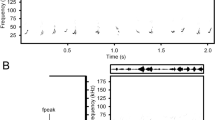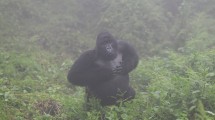Abstract
The vocal repertoire in common marmosets (Callithrix jacchus) has been assumed to consist not only of vocalizations audible to humans but also of ultrasonic vocalizations (USVs). The use of USVs to socially indicate distress has not been evaluated in this species, however. The authors analyzed the ultrasonic vocal repertoire of the common marmoset under normal housing conditions, under various experimental manipulations intended to elicit positive or negative emotional responses and during stressful experiences including blood draw and exposure to a perceived predator. Analysis of the recordings showed that marmosets produced vocalizations with ultrasonic components as part of their normal vocal repertoire, but these vocalizations all have audible components as well. Only 4 of the 13 types of vocalizations had ultrasonic components. These ultrasonic components were not reliably associated with responses to different experimental manipulations, suggesting that they are not used to indicate pain, discomfort or distress.
This is a preview of subscription content, access via your institution
Access options
Subscribe to this journal
We are sorry, but there is no personal subscription option available for your country.
Buy this article
- Purchase on Springer Link
- Instant access to full article PDF
Prices may be subject to local taxes which are calculated during checkout


Similar content being viewed by others
References
Murrant, M.N. et al. Ultrasonic vocalizations emitted by flying squirrels. PLoS ONE 8, e73045 (2013).
Arch, V.S., Grafe, T.U., Gridi-Papp, M. & Narins, P.M. Pure ultrasonic communication in an endemic Bornean frog. PLoS ONE 4, e5413 (2009).
Arch, V.S. & Narins, P.M. “Silent” signals: Selective forces acting on ultrasonic communication systems in terrestrial vertebrates. Anim. Behav. 76, 1423–1428 (2008).
Brudzynski, S.M. Communication of adult rats by ultrasonic vocalization: biological, sociobiological, and neuroscience approaches. ILAR J. 50, 43–50 (2009).
Yu, P. et al. The effects of repeated early deprivation on ultrasonic vocalizations and ontogenetic development in mandarin vole pups. Behav. Processes 88, 162–167 (2011).
Clausen, K.T., Malmkvist, J. & Surlykke, A. Ultrasonic vocalizations of kits during maternal kit-retrieval in farmed mink, Mustela vison. Appl. Anim. Behav. Sci. 114, 582–592 (2008).
Bezerra, B.M. & Souta, A. Structure and usage of the vocal repertoire of Callithrix jacchus. Int. J. Primatol. 29, 671–701 (2008).
Epple, G. Comparative studies on vocalization in marmoset monkeys (Hapalidae). Folia Primatol. (Basel) 8, 1–40 (1968).
Goldman, J.A. Acoustic communication in the common marmoset monkey (Callithrix jacchus jacchus) measurements of transmissions and responses. PhD Dissertation, York University, Toronto, Canada (2000).
Jones, B.S. Vocal behaviour of the common marmoset: structure and function of selected calls. Primate Eye 53, 22–23 (1993).
Mendes, S.L., Vielliard, J.M.E. & De Marco, P. in The Smallest Anthropoids: The Marmoset/Callimico Radiation (Developments in Primatology: Progress and Prospects) (eds. Ford, S.M., Porter, L.M. & Davis, L.C.) 63–84 (Springer, New York, NY, 2009).
Miller, C.T., Mandel, K. & Wang, X. The communicative content of the common marmoset phee call during antiphonal calling. Am. J. Primatol. 72, 974–980 (2010).
Morrill, R.J., Thomas, A.W., Schiel, N., Souto, A. & Miller, C.T. The effect of habitat acoustics on common marmoset vocal signal transmission. Am. J. Primatol. 75, 904–916 (2013).
Norcross, J.L., Newman, J.D. & Cofrancesco, L.M. Context and sex differences exist in the acoustic structure of phee calls by newly-paired common marmosets (Callithrix jacchus). Am. J. Primatol. 49, 165–181 (1999).
Pistorio, A.L., Vintch, B. & Wang, X. Acoustic analysis of vocal development in a New World primate, the common marmoset (Callithrix jacchus). J. Acoust. Soc. Am. 120, 1655–1670 (2006).
Ramsier, M.A. et al. Primate communication in the pure ultrasound. Biol. Lett. 8, 508–511 (2012).
Stevenson, M.F. & Poole, T.B. An ethogram of the common marmoset (Calithrix jacchus jacchus): general behavioural repertoire. Anim. Behav. 24, 428–451 (1976).
Stevenson, M.F. & Rylands, A.B. in Ecology and Behavior of Neotropical Primates vol. 2. (eds. Mittermeier, R.A., Rylands, A.B., Coimbra-Filho, A.F. & Fonseca, G.A.B.) 131–222 (World Wildlife Fund, Washington, DC, 1988).
Watson, C.F. & Caldwell, C.A. Neighbor effects in marmosets: social contagion of agonism and affiliation in captive Callithrix jacchus. Am. J. Primatol. 72, 549–558 (2010).
Yamaguchi, C., Izumi, A. & Nakamura, K. Temporal rules in vocal exchanges of phees and trills in common marmosets (Callithrix jacchus). Am. J. Primatol. 71, 617–622 (2009).
Yamaguchi, C., Izumi, A. & Nakamura, K. Time course of vocal modulation during isolation in common marmosets (Callithrix jacchus). Am. J. Primatol. 72, 681–688 (2010).
Anderson, J.W. The production of ultrasonic sounds by laboratory rats and other mammals. Science 119, 808–809 (1954).
Osmanski, M.S. & Wang, X. Measurement of absolute auditory thresholds in the common marmoset (Callithrix jacchus). Hear. Res. 277, 127–133 (2011).
Gerber, P., Schnell, C.R. & Anzenberger, G. Behavioral and cardiophysiological responses of common marmosets (Callithrix jacchus) to social and environmental changes. Primates 43, 201–216 (2002).
Abbott, D.H., Barnett, D.K., Colman, R.J., Yamamoto, M.E. & Schultz-Darken, N.J. Aspects of common marmoset basic biology and life history important for biomedical research. Comp. Med. 53, 339–350 (2003).
Mansfield, K. Marmoset models commonly used in biomedical research. Comp. Med. 53, 383–392 (2003).
Burman, O.H.P., Ilyat, A., Jones, G. & Mendl, M. Ultrasonic vocalizations as indicators of welfare for laboratory rats (Rattus norvegicus). Appl. Anim. Behav. Sci. 104, 116–129 (2007).
Kikusui, T., Nishizawa, D., Takeuchi, Y. & Mori, Y. Conditioned fear-related ultrasonic vocalizations are emitted as an emotional response. J. Vet. Med. Sci. 65, 1299–1305 (2003).
Takahashi, N., Kashino, M. & Hironaka, N. Structure of rat ultrasonic vocalizations and its relevance to behavior. PLoS ONE 5, e14115 (2010).
Wöhr, M. & Schwarting, R.K. Ultrasonic communication in rats: can playback of 50-kHz calls induce approach behavior? PLoS ONE 2, e1365 (2007).
Portfors, C.V. Types and functions of ultrasonic vocalizations in laboratory rats and mice. J. Am. Assoc. Lab. Anim. Sci. 46, 28–34 (2007).
Williams, W.O., Riskin, D.K. & Mott, A.K. Ultrasonic sound as an indicator of acute pain in laboratory mice. J. Am. Assoc. Lab. Anim. Sci. 47, 8–10 (2008).
Jagessar, S.A. et al. Overview of models, methods, and reagents developed for translational autoimmunity research in the common marmoset (Callithrix jacchus). Exp. Anim. 62, 159–171 (2013).
Cagni, P., Sampaio, A.C., Ribeiro, N.B. & Barros, M. Immediate, but no delayed, behavioral response to a snake model by captive black tufted-ear marmosets. Behav. Processes 87, 241–245 (2011).
Clara, E., Tommasi, L. & Rogers, L.J. Social mobbing calls in common marmosets (Callithrix jacchus): effects of experience and associated cortisol levels. Anim. Cogn. 11, 349–358 (2008).
Emile, N. & Barros, M. Recognition of a 3D snake model and its 2D photographic image by captive black tufted-ear marmosets (Callithrix penicillata). Anim. Cogn. 12, 725–732 (2009).
Kaplan, G., Pines, M.K. & Rogers, L.J. Stress and stress reduction in common marmosets. Appl. Anim. Behav. Sci. 137, 175–182 (2012).
Norcross, J.L. & Newman, J.D. Context and gender-specific differences in the acoustic structure of common marmoset (Callithrix jacchus) phee calls. Am. J. Primatol. 30, 37–54 (1993).
Boere, V., Paludob, G.R., Pianta, G., Canale, C. & Tomaz, C. Effects of novelty, isolation stress, and environmental enrichment on some haematological parameters in marmosets (Callithrix penicillata). Comp. Biochem. Phys. Pharm. Tox. 119, 261–274 (2003).
Ely, A., Freer, A., Windle, C. & Ridley, R.M. Assessment of cage use by laboratory-bred common marmosets (Callithrix jacchus). Lab. Anim. 32, 427–433 (1998).
Searcy, Y.M. & Caine, N.G. Hawk calls elicit alarm and defensive reactions in captive Geoffroy's marmosets (Callithrix geoffroyi). Folia Primatol. (Basel) 74, 115–125 (2003).
Winter, M. in Biology and Behaviour of Marmosets: Proceedings of the Marmoset Workshop, Göttingen, West Germany, 2–5 September 1977 (eds. Rothe, H., Wolters, H.J. & Hearn, J.P.) 127–139 (H. Rothe, Göttingen, Germany, 1978).
Acknowledgements
We thank Herma van der Wiel for critical reading of the manuscript and Donna Devine and Thea de Koning for editing the manuscript. We also thank Henk van Westbroek for optimizing the graphs and figures. This study was funded in part by a grant from the EUPRIM-Net Project.
Author information
Authors and Affiliations
Corresponding author
Ethics declarations
Competing interests
The authors declare no competing financial interests.
Rights and permissions
About this article
Cite this article
Bakker, J., van Nijnatten, T., Louwerse, A. et al. Evaluation of ultrasonic vocalizations in common marmosets (Callithrix jacchus) as a potential indicator of welfare. Lab Anim 43, 313–320 (2014). https://doi.org/10.1038/laban.568
Received:
Accepted:
Published:
Issue Date:
DOI: https://doi.org/10.1038/laban.568



